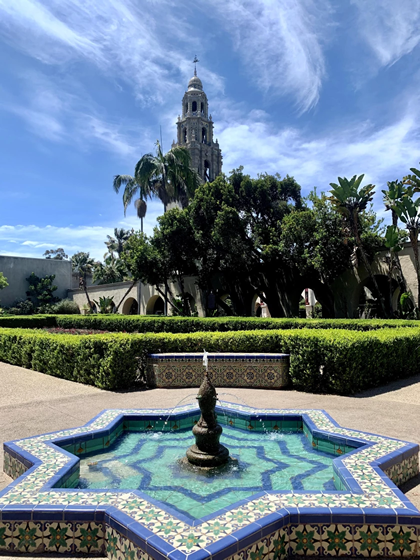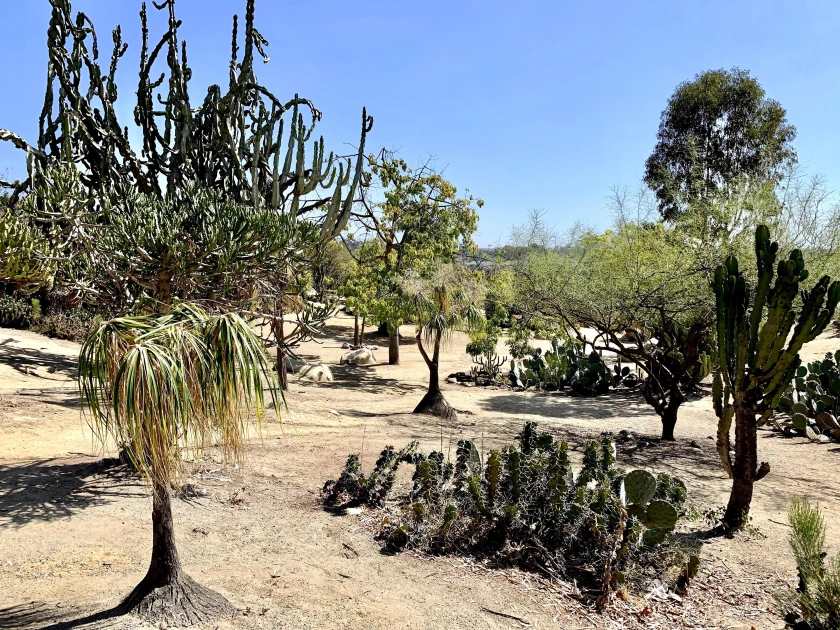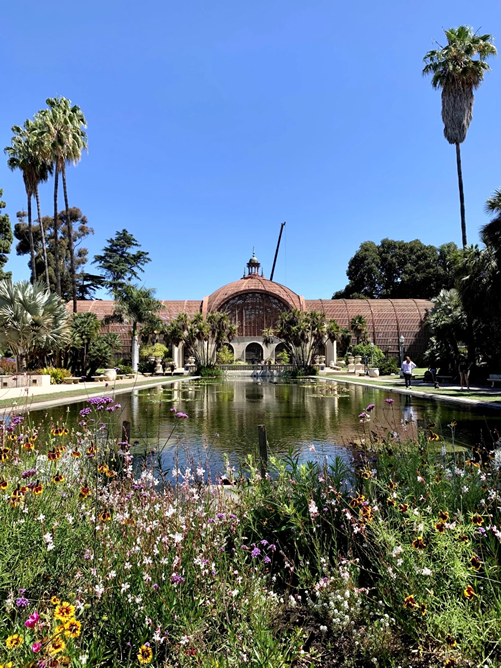Balboa Park dazzles with acres of gems — in our own backyard

The walled, formal Alcazar Garden, patterned after a castle garden in Spain, showcases colorful Moorish tiles, fountains, boxwood hedges and seasonal floral displays.(Helen Purcell Montag)
BY HELEN PURCELL MONTAG
(This article first appeared in the San Diego Union-Tribune on August 14, 2021)
The easing of pandemic restrictions has made this summer a wonderful time to enjoy and rediscover many of the activities that San Diego has to offer. Here’s a suggestion for outdoor enthusiasts: Pick a day, bring a friend or two, and visit the beautiful gardens within San Diego’s “crown jewel,” Balboa Park.
Before it was Balboa Park, the land was the ancestral home of the Kumeyaay people. A bird’s-eye view would show mesas and canyons covered with chaparral and coastal sage scrub. In 1868, San Diego’s civic leaders set aside 1,400 acres for a park. “City Park,” as it was called, sat for years without formal landscaping or development.
In 1892, beautification began when city officials entered into a 10-year lease agreement with horticulturalist Kate Sessions for land at the edge of City Park. Sessions agreed to plant 100 trees per year within the mostly barren park. As the 20th century began, businessman and philanthropist George Marston gave financial support to the continuing efforts for transforming City Park. By 1910, City Park’s name was officially confirmed as “Balboa Park.”
The park hosted its first world exposition in 1915. The Panama-California Exposition promoted San Diego and celebrated the opening of the Panama Canal. A second exposition, held in 1935, was called The California Pacific International Exposition. Both events left indelible legacies, including the distinct Spanish Colonial Revival buildings throughout Balboa Park. Equally spectacular are the enduring landscapes of the park’s beautiful gardens. Many can trace their origins to the 1915 or 1935 expositions. Other gardens are “newer.” All are beautiful — and invite visitors to pause, reflect, admire and be inspired.

The 2.5-acre Desert Garden at Balboa Park contains more than 1,300 plants, including many from around the world.
Desert Garden
The Desert Garden is a showcase for succulents, cactuses, and other drought-resistant plants from around the world. This 2.5-acre garden is contemplative, quiet and peaceful. The winding paths invite you to view plants and trees with interesting and unusual shapes, such as the Candelabra Tree and Crown of Thorns.
Ynez Grant Parker Memorial Rose Garden
At the Ynez Grant Parker Memorial Rose Garden’s 3-acre site, everything’s been coming up roses since it was founded by Dick Streeper in 1974. Enjoy the meandering walkways as you admire 1,700 roses, from hybrid teas and floribundas, to grandifloras, shrubs, ramblers and more. Try to decide which is your favorite rose type, color or fragrance. If you like fragrant roses, look for ‘Neil Diamond,’ ‘Firefighter,’ ‘Rock & Roll’ and ‘Sugar Moon.’ The expansive gazebo offers cool shade on a hot day.
Zoro Garden
The Zoro Garden wins top prize for having the most colorful history. In 1935, it was the site of the Zoro Garden Nudist Colony. Visitors were charged an entrance fee, and the attraction was hugely popular. Today the garden has been redesigned to include plants that sustain each stage of a butterfly’s life cycle. Partly shaded and with rocky outcroppings surrounded by tiered walkways, the garden invites visitors down to admire milkweed plants, lantanas, passion vines and California lilacs. You may find a hanging chrysalis, caterpillars on leaves or monarch butterflies fluttering about.

The iconic Botanical Building and Lily Pond is one of the most-photographed places in San Diego, for good reason. Inside are ferns, cycads, orchids and more.(Helen Purcell Montag)
Botanical Building and Lily Pond
For something grand, something spectacular, head over to the Botanical Building with the Lily Pond dramatically reflecting its wood lath structure. Inside, you’ll find ferns of all sizes, cycads, tall palm trees, orchids, bromeliads and yes, even carnivorous plants. The dappled light is ideal for taking photographs. Outside, look for the Lily Pond’s succulents and drought-tolerant plantings, a contribution of the Friends of Balboa Park’s Adopt-a-Plot program. You’ll find these signs in gardens throughout the park.
The nearby Japanese Friendship Garden is serene, refreshing and soothing to all your senses. Its history dates to the 1915 exposition, when the Japanese government presented a Tea House to San Diego. Affirming the symbol of friendship between the U.S. and Japan, the San-Kei-En garden reopened in 1991. Observe all the details around you, so typical of the Japanese garden aesthetic. The winding paths are dotted with benches, boulders, waterfalls, koi ponds, statues and a ceremonial gate. Not to be missed is the area that showcases the bonsai collection.
May S. Marcy Sculpture Garden
Art meets nature at the May S. Marcy Sculpture Garden. The three-dimensional modern and contemporary sculptures invite physical interaction with visitors. They also lend visual definition to the space, as if the garden space itself has been sculpted. Enjoy the backdrop of palm trees and close-up views of the California Tower. If you’re there at the hour or half-hour, you’ll hear musical chimes coming from the Tower’s carillon.
Alcazar Garden
Alcazar Garden is a walled, formal courtyard garden reminiscent of the romantic gardens of Alcázar Castle in Seville, Spain. A homage to symmetry, this gem of a garden has two ornate fountains and eight benches intricately decorated with turquoise, blue, yellow and green Moorish tiles. The shaded pergola is draped in vines, and there are four colorfully landscaped areas bordered by classic boxwood hedges. Take in all the design elements. The California Tower is prominent in the background, and you’ll want to linger awhile.
Founders Plaza
The iconic, multiple-arched Cabrillo Bridge takes you to Founders Plaza near the west entrance of Balboa Park, our last stop. With panoramic views of downtown and the San Jose Hesper palms scattered throughout Cabrillo canyon, a different “bird’s-eye-view” comes to mind. Long ago in 1868, the aerial view was mesa tops and canyons. Today we appreciate the historical perspective of how the park came to be and evolved over time.
Look for the bronze statues of Kate Sessions, Ephraim Morse, Alonzo Horton and George Marston. Morse and Horton collaborated to set aside the large plot of land that became “City Park.” Sessions and Marston worked tirelessly to create, beautify and develop the park. Without all four, there would be no Balboa Park as we know and enjoy it today. Known for its motto “ever changing, always amazing,” there are acres of diamonds waiting for you to explore and enjoy. This is your park, San Diego. I hope you’ll visit soon!
Helen Purcell Montag is a UC Master Gardener who also enjoys travel, history, writing, genealogy and speaking Spanish.

